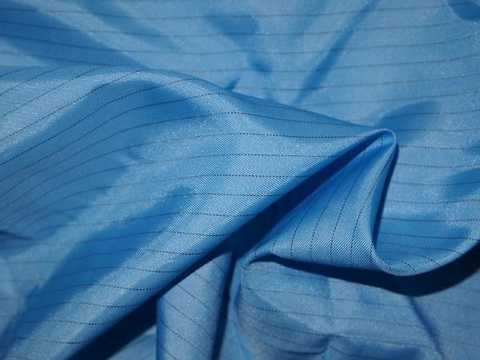Anti-static fabric is a fabric that has been treated with anti-static treatment. In the current process, there are three antistatic processing methods for fabrics: 1 fabric finishing with antistatic finishing agent; 2 fiber grafting modification for the purpose of improving fabric moisture absorption, blending and interweaving of hydrophilic fibers; 3 blending Or inlaid conductive fibers. The mechanism of action of the first two methods is to improve the moisture regain of the fabric, reduce the insulation, and accelerate the electrostatic leakage. Therefore, if the processing effect is not durable or inconspicuous in a dry environment or after repeated washing, it is usually applied to a fabric for general clothing. The third method can solve the static problem of textiles permanently and efficiently, so it is widely used in the production of anti-static overalls. So what is the difference between ordinary anti-static fabrics and anti-static super fabrics? Today we will take a look at the difference between anti-static and ultra-clean fabrics and ordinary anti-static fabrics. The difference between anti-static and ultra-clean fabrics and general anti-static fabrics lies in the concept of “super cleanâ€. Anti-static ultra-clean fabric has the following three characteristics: A, with anti-static function: Static electricity absorbs dust and makes the adsorbed dust not easily blown away when it is exposed to the air. Therefore, the primary feature of the antistatic ultra-clean cloth is to have an antistatic function. Together, this anti-static function needs to be durable and efficient, and will not be significantly attenuated due to the usual scrubbing and conflict. B, the cloth itself does not dust: Because it is worn in a clean room, it is required that the cloth cannot become a source of dust in the clean room, which determines that the ultra-clean cloth can only be produced by chemically synthesized long fibers. Natural short fibers such as cotton, hemp, and silk cannot be used in ultra-clean fabrics, although these materials can make the fabrics more pleasing. The chemical fiber filaments selected for the demand must also be strictly controlled. In general, full-dull polyester filaments are not suitable for woven anti-static ultra-clean fabrics. Titanium dioxide, a matting agent that participates in the production of polyester, becomes a source of pollution. C, the fabric should have outstanding dust filter: The dust in the clean room comes mainly from the indoor air and the human body moving indoors. When the equipment conditions are determined, the cleanliness is also the limit of the demand to control the fine dust generated by the human body in the clothes, let it through the cloth into the air. This is the so-called cloth filter with a high dust rate. Progressive dust filtration rates are at the expense of the breathability of the fabric, so knitted fabrics and woven fabrics that are loosely woven are not suitable for use in clean rooms. Editor in charge: Xu Yuehua
Carbon fiber composites are materials made from carbon fibers and a polymer matrix, typically epoxy. Carbon fibers are thin strands of carbon atoms that are extremely strong and lightweight. They are made by heating synthetic fibers, such as polyacrylonitrile, and then carbonizing them at high temperatures.
Carbon Fiber Composites,Fiber Composites,Forged Composite,Cfrp Composite Jiangyin Phecda New Material Technology Co., Ltd , https://www.jiangyinphecda.com